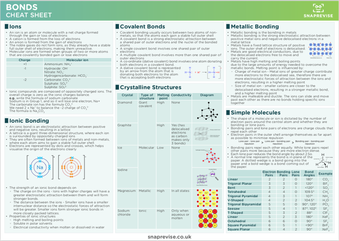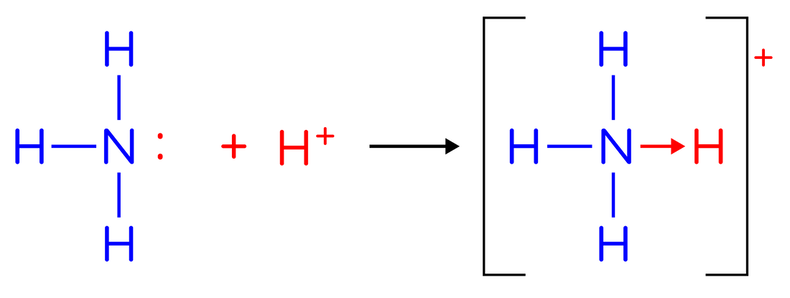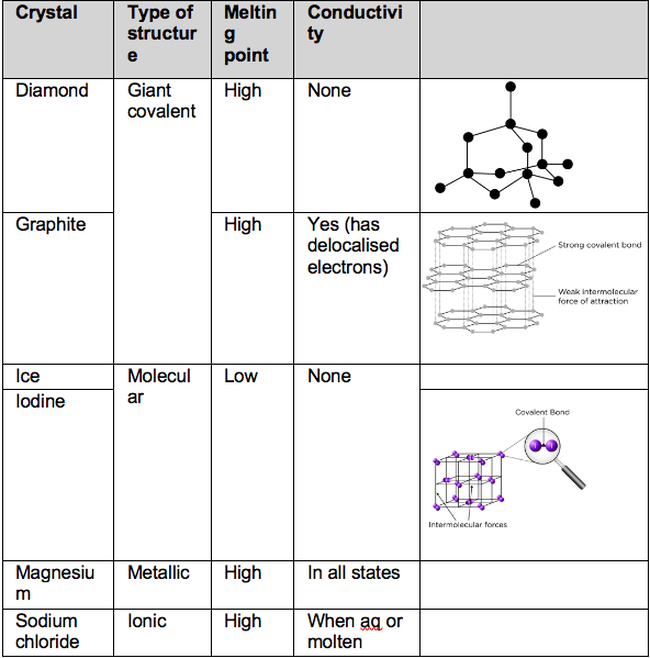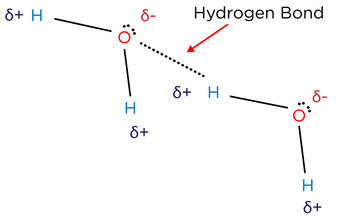A-LEVEL AQA ChEMISTRY NOTES
bonding
Ions
- An ion is an atom or molecule with a net charge formed through the gain or loss of electrons
- A cation is formed from the loss of electrons
- An anion is formed from the gain of electrons
- The noble gases do not form ions, as they already have a stable full outer shell of electrons, making them unreactive.
- Molecular ions are formed when groups of two or more atoms that are covalently bonded gain or lose electrons
Charge |
Molecular ion |
+1 |
Ammonium: NH4+ |
-1 |
Hydroxide: OH^- Nitrate: NO3- Hydrogencarbonate: HCO3- |
-2 |
Carbonate: CO3^2- Sulphate: SO4^2- Sulphite: SO3^2- |
- Ionic compounds are composed of oppositely charged ions. The overall charge is zero as the ionic charges balance.
- e.g. write the formula of sodium carbonate
We need 2 x Na+ to balance the -2 charge of CO3^2-
The formula is Na2CO3
The formula is Na2CO3
Covalent Bonds
- Covalent bonding usually occurs between two atoms of non-metals, so that the atoms each gain a stable full outer shell
- A covalent bond is a strong electrostatic attraction between a shared pair of outer electrons and the nuclei of the bonded atoms
- A single covalent bond involves one shared pair of outer electrons, while a multiple covalent bond involves more than one shared pair of outer electrons
- A co-ordinate (dative covalent) bond involves one atom donating both electrons in a covalent bond.
- A dative covalent bond is represented by an arrow from the atom that is donating both electrons to the atom that is accepting both electrons
Ionic Bonding
- An ionic bond is an electrostatic attraction between positive and negative ions, resulting in a lattice
- A lattice is a giant three-dimensional structure, where each ion is surrounded by oppositely charged ions
- They are often formed between ions of metals and non-metals, where each atom aims to gain a stable full outer shell.
- Electrons are represented by dots and crosses, which helps visualise the origin of the electrons clearly
- The strength of an ionic bond depends on
- The charge on the ions- Ions with higher charges will have a greater electrostatic attraction between them
- The distance between the ions- Smaller ions have a smaller internuclear distance so the electrostatic forces of attraction will be greater, and they can pack more closely
- Properties of ionic structures
- High melting and boiling points
- Soluble in polar solvents
- Electrical conductivity when molten or dissolved in water
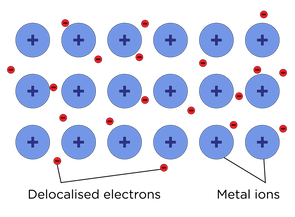
Metallic Bonding
- Metallic bonding is the strong electrostatic attraction between positive metal ions and negative delocalised electrons in a metal lattice
- Metals have a fixed lattice structure of positive ions. The outer shell of electrons is delocalised, which can carry current.
- Metals have high melting and boiling points due to the large amounts of energy needed to overcome the metallic bonds.
- The greater the charge of a metal ion, the more electrons are delocalised. The smaller the size of the metal ions, the closer they are to the delocalised electrons. This results in stronger bonds and a higher melting point
- Metals are malleable and ductile. The ions can slide and move past each other as there are no bonds holding specific ions together
Crystalline Structure
Simple Molecules
- Bonding pairs and lone pairs of electrons are charge clouds that repel each other
- Electron pairs in the outer shell arrange themselves as far apart as possible to minimise repulsion
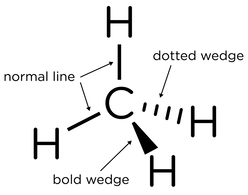
- Bonding pairs repel each other equally. While lone pairs repel other pairs more because they are more electron dense.
- Each lone pair reduces the bond angle by about 2.5 degrees.
- A normal line represents the bond is in plane of the paper. A dotted wedge is a bond going into the paper and a bold wedge is a bond coming out of the paper.
Electron Pairs |
Bonding Pairs |
Lone Pairs |
Bond Angles |
Example |
|
Linear |
2 |
2 |
180⁰ |
CO2 |
|
Trigonal Planar |
3 |
3 |
120⁰ |
BF3 |
|
Bent |
3 |
2 |
1 |
<120⁰ |
SO2 |
Tetrahedral |
4 |
4 |
109.5⁰ |
CH4 |
|
Trigonal Pyramidal |
4 |
3 |
1 |
107⁰ |
NH3 |
V-Shaped |
4 |
2 |
2 |
104.5⁰ |
H2O |
Trigonal Bipyramidal |
5 |
5 |
90⁰, 120⁰ |
PCl5 |
|
Seesaw |
5 |
4 |
1 |
87⁰, 102⁰ |
SF4 |
T-Shaped |
5 |
3 |
2 |
88⁰ |
ClF3 |
Linear |
5 |
2 |
3 |
180⁰ |
XeF2 |
Octahedral |
6 |
6 |
90⁰ |
SF6 |
|
Square Pyramidal |
6 |
5 |
1 |
<90⁰ |
BrF5 |
Square Planar |
6 |
4 |
2 |
90⁰ |
XeF4 |
Bond Polarity
- Electronegativity is the power of an atom to attract the pair of electrons in a covalent bond. It is affected by:
- Nuclear charge
- Atomic radius
- Shielding by electrons in inner shells
- A polar bond will form between two atoms with different electronegativity values where the electrons in the bond are not shared equally. This causes a permanent dipole.
- Partial negative charges (δ-), and partial positive charges (δ+) are used to show that a bond is polar.
- Molecules containing polar bonds are not always polar. The symmetry of polar bonds can cancel the effect of any permanent dipole.
Intermolecular Forces
- Intermolecular interactions are the forces of attraction between molecules that do not involve the transfer of electrons. They are the result of the constant and random movements of electrons within electron shells
- The greater the strength of the bonds, the higher the melting and boiling points. E.g., down a group boiling point increases, due to greater induced dipole=dipole forces, as electron number increases
- Induced dipole-dipole forces are caused by the temporary unequal distribution of charge due to the constantly moving electrons. The temporary dipole can induce a temporary dipole in a neighbouring atom and the two dipoles will be attracted to each other. This can occur between almost all molecules.
- Permanent dipole-dipole forces are caused by molecules with a permanent dipole being attracted to the opposite charge in other permanent dipoles, if correctly aligned.
- Hydrogen bonding requires:
- An electron-deficient hydrogen atom and a more electronegative atom. These atoms are oxygen, fluorine and nitrogen
- A lone pair of electrons on a highly electronegative atom on another molecule
- Hydrogen bonding in water allows ice to be less dense than water as hydrogen bonds hold the water molecules apart at a fixed position, forming an open lattice
- Water has high melting and boiling points than expected due to hydrogen bonds being the strongest intermolecular forces

